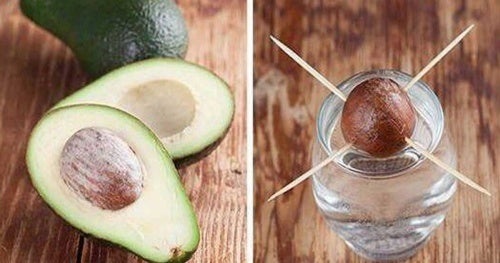To germinate the avocado pit it is important to keep it in a place where it receives light and heat. If the temperatures are lower than 7 ºC, the plant must be kept inside the house. Today, avocado is valued as one of the most delicious and complete foods from a nutritional point of view. What many do not know is that, from its seed, it can be germinated at home with a few simple tricks.

Next we are going to share a very interesting method that you will surely want to try yourself. Do not miss it!
What should you know about avocado?
Although for many years it was excluded from the diet because it was thought to be fattening, now most people consume it regularly, because it has been shown to provide healthy fats that are necessary for health and organic balance.
Its high content of protein, essential fatty acids and antioxidant compounds support all meal plans and contribute to healthy weight loss.
The cultivation of its tree occurs mainly in Central and South America, but it has spread too many other corners of the world to meet the demand in the market.
How to germinate an avocado tree from its pit?
The pit or seed of the avocado is the part that we commonly throw away when we eat its exquisite pulp.
However, it has been shown that important properties are concentrated in this, since it is the one that houses 70% of the total amino acids of the whole fruit, in addition to containing flavonoids, antioxidant substances and fiber.
Due to this, it is not surprising that many are already using it to make various types of natural remedies, and also as a basis for germinating their own tree.
As many are interested in giving it this last end, we wanted to share the steps to make it very easy at home.
Materials:
- 1 avocado seed.
- 1 glass of water (250 ml).
- 4 long toothpicks.
- 1 pot.
Step 1.
To begin with, you will have to remove the avocado pit and, without cutting it, thoroughly wash all the pulp residue that remains in its surroundings.
A good option is to immerse it for a few minutes, although care must be taken because the brown coating cannot be removed.
Step 2.
What we will do next is to locate the top and bottom of the seed. The roots will come out at the bottom and the stems at the top. Note that the top is a bit pointy.
Step 3.
Take the four long toothpicks and insert them into the seed, in such a way that it allows you to hold it in a glass of water. Here you will have to verify that the lower part of the bone is submerged.
Step 4.
The glass of water must be translucent to be able to monitor the growth of the roots and thus know when it is time to change the water. Ideally, do it every 5 or 7 days, or a little earlier if you notice that it is very dirty.
Step 5.
More or less between 2 and 4 weeks later, the first changes in the seed will begin to be noticed. At 8 weeks the first shoots will appear. The upper part will completely dry out and a crack will appear.
At the bottom you will notice the roots, which must always be kept in sufficient fresh water.
Step 6.
To encourage the plant to grow healthily, cut the stem when it has grown to 17-20 centimeters.
If you reduce it to about 9 centimeters, it will be enough to obtain this effect.
Step 7.
When the stem reaches 20 centimeters long again, it must be transplanted into a pot to continue its growth process.
Remember to leave half of the bone uncovered so that it is not affected.
Step 8.
The avocado tree requires good sun, so it is best to put it in a space where it receives light and heat.
Water it frequently, as its soil should keep slightly moist. If you notice that the leaves begin to look yellow, stop watering for a couple of days.
In summer you can keep this plant in the garden so that it benefits from the climate. If in winter the temperature is lower than 7 ºC, put it inside the house.
We recommend you put several seeds to germinate, so that they will bear fruit at least two are required for their pollination.
It is essential to be very patient because this process requires a lot of time, dedication and care.

